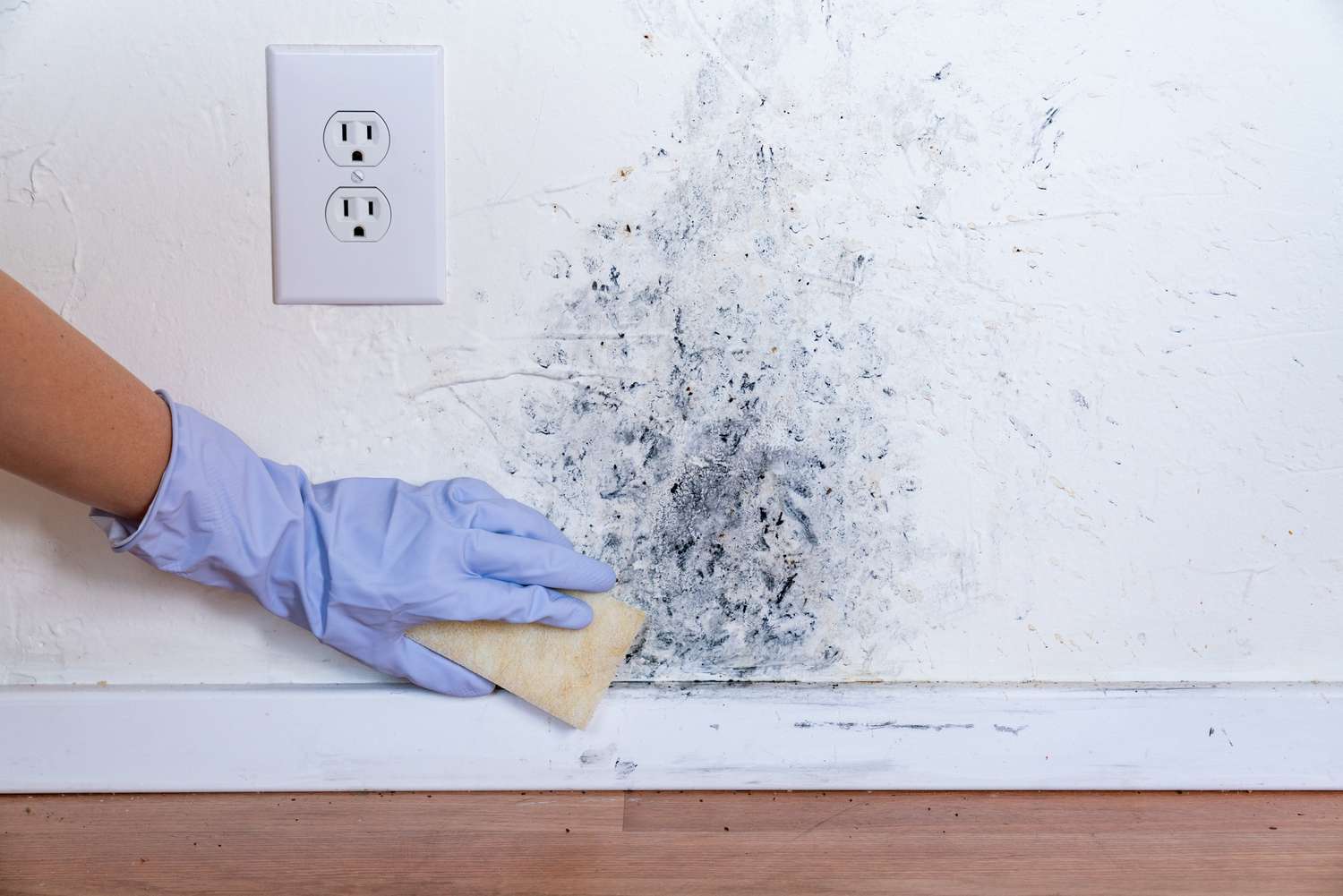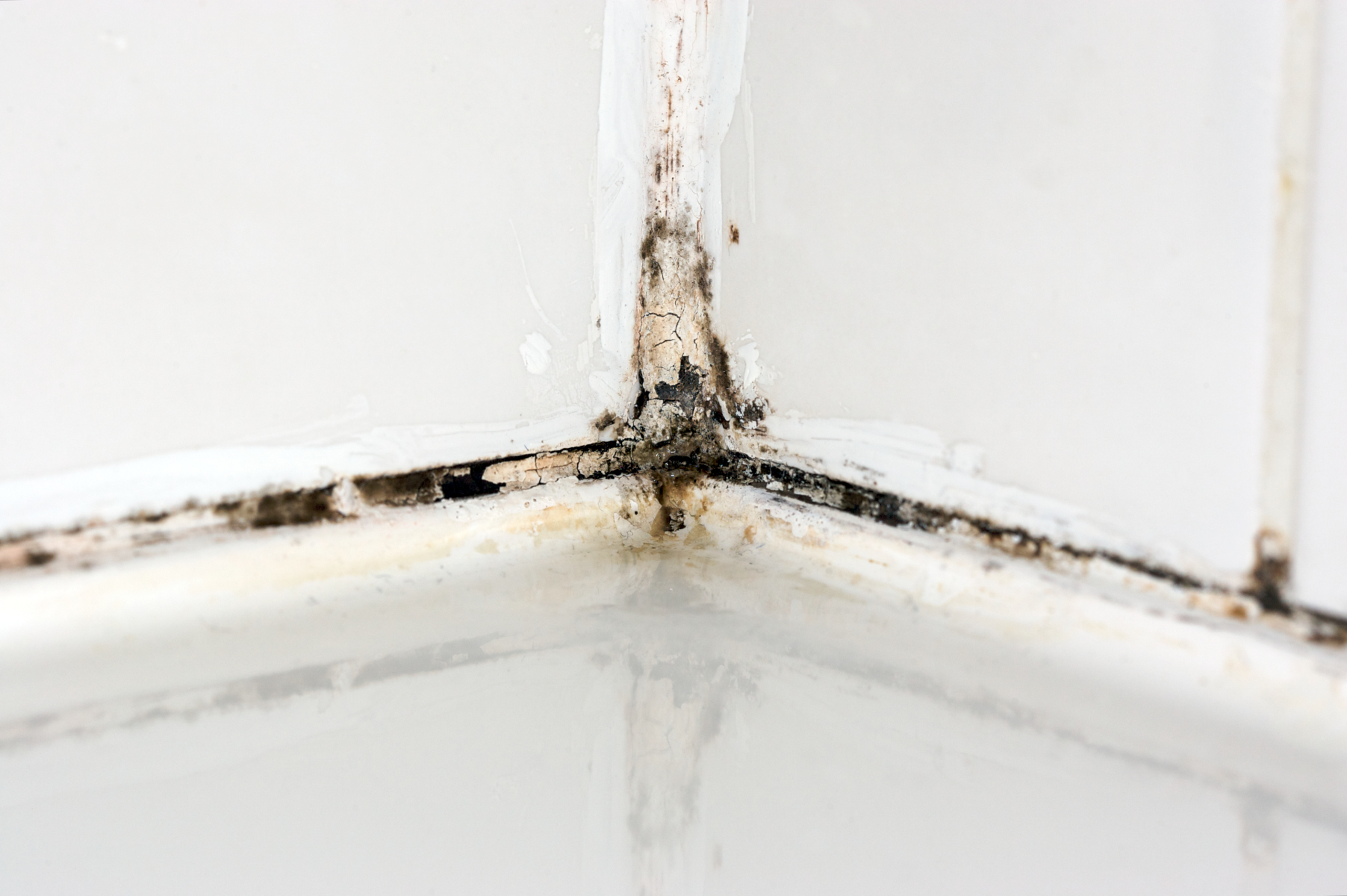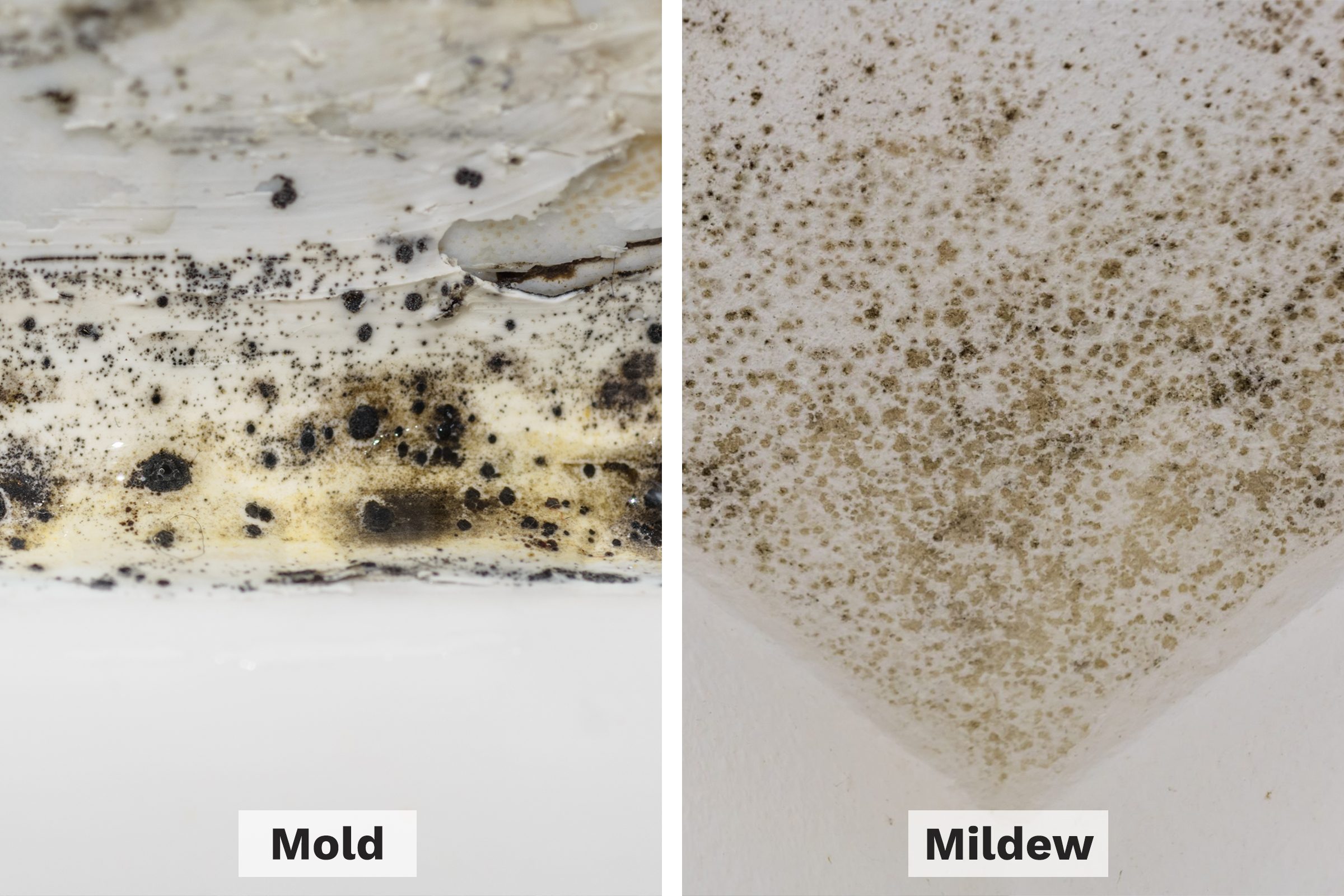Mold and mildew are the two most common types of house problems that you might have to encounter as a homeowner. These types can grow in damp environments or areas of your home and pose various health risks for your home and family.
Mold vs mildew comparison: At first glance, you might think they look similar, but some notable differences can help you recognize which type is present in your home. Let’s explore the differences between the two and some tips for identifying these irritating fungi. Let’s get started.
What Is Mold?
Mold is a variety of microscopic fungi that thrives in moist and humid surroundings. It appears as black, green, or white fuzzy patches on walls, ceilings, floors, and other surfaces. It can cause health problems such as respiratory issues, allergies, and infections. Mold can also weaken the structural integrity of a building and cause it to decay over time.
What is Mildew?
Mildew refers to a fungus similar to mold in appearance and growth conditions. It is usually white or gray and grows in damp areas such as bathrooms, kitchens, and laundry rooms. Mildew can cause health problems such as respiratory issues and allergies. Unlike Mold, Mildew typically does not cause significant damage to the structural integrity of a building.
Causes Of Mold And Mildew Growth
Mold and mildew are like uninvited guests that need a specific environment to grow in. They crave organic materials such as wood, insulation, and even clothing, and they love to thrive in damp conditions where light is scarce. Their journey begins when their spores find a suitable spot to start a colony.
While these spores are usually harmless, things can quickly turn worse when they enter an indoor space with ideal conditions – heat, humidity, and darkness. Once they find their way into such an area, they quickly attach and multiply, creating an unpleasant and sometimes even dangerous situation.
Mold Vs Mildew – The Differences
Regarding unwanted fungi in the home, mold, and mildew are at the top of the list. But while they may seem similar, the two have critical differences.
1. Removal
Mildew is the less aggressive of the two and can be easily tackled with a store-bought cleaner and some elbow grease. On the other hand, mold is often part of a larger infestation that requires professional help as it burrows deep into its host, causing severe damage.
2. Appearance Matters
Mildew is usually grayish-white and powdery in appearance, with a foul smell. Mold is typically black or green, with a fuzzy texture and foul odor.
3. Health Risks
Both mold and mildew can cause respiratory problems such as coughing and sneezing. However, Mold is the more significant threat, especially to those with pre-existing health conditions such as asthma or lung disease, which can lead to chest tightness.
4. Take Action
Spotting mold or mildew in your home means it’s time to take action sooner rather than later, as the longer they’re left untreated, the bigger the problem can become.
Common Types of Mold Vs Mildew
Mold
Indoor mold typically has a dark appearance and may be described as hairy in texture. It can grow into surfaces, which can make it challenging to remove. The following types of mold are commonly found indoors:
- Cladosporium: Cladosporium is a mold that may appear in shades of brown, green, or black. It can grow in hot and cold areas and is frequently found on wood, carpets, fabrics, and heating/cooling ducts.
- Penicillium: Penicillium is a fuzzy mold that can look blue, green, or yellow. It is frequently discovered under carpets, basements, and insulation, especially after water damage.
- Aspergillus: Aspergillus is a powdery mold that may be green, white, or gray with dark spots. It can grow in walls, attics, basements, fabrics, and dry food items and only requires a little ventilation to thrive.
- Aureobasidium: Aureobasidium is a pink mold with black spots commonly found on wood, walls, caulking, and grout in crawl spaces.
- Stachybotrys Chartarum: Black mold, also known as Stachybotrys Chartarum, is a greenish-black mold that emerges on substances that contain a high level of cellulose, such as paper, gypsum board (drywall), and fiberboard.

Mildew
Mildew is a fungus that thrives on damp surfaces such as clothing, paper, leather, walls, ceilings, and floors. There are various types of mildew, each with unique characteristics and potential health risks.
- Basidiospores: This type of mildew is commonly associated with dry-rotted wood. Over time, these mildew spores can turn into mushrooms and cause severe allergic reactions in some individuals.
- Aureobasidium: Aureobasidium Mildew, or “bathroom mold,” is typically found in showers and bathtubs. Mildew can cause respiratory issues, particularly in people with pre-existing conditions such as asthma.
- Botrytis: It is commonly found in humid greenhouses and indoor plants. It can trigger asthma symptoms in sensitive individuals.
- Rhizopus: Rhizopus is a dangerous type of Mildew that can harm individuals with pre-existing health conditions or nutritional deficiencies. It is commonly found in the garbage, house dirt, and food and can cause serious health problems if ingested.
Habitats of Mold Vs Mildew
Mold and mildew have their preferences when it comes to choosing their habitats. Mold, for instance, is the fungus that commonly grows on food, which we’ve all experienced at one point or another. But it’s not just limited to our meals; it can grow in damp basements, even without flooding. It’s an opportunistic organism that will take root wherever there is a combination of warmth, moisture, darkness, and oxygen. You might find it lurking in the corners of a room, on walls, furniture, insulation, or even in mattresses.
On the contrary, mildew is a fungus that remains on the surface of its host and doesn’t invade its interior. It prefers to grow in areas with high humidity, such as bathrooms, kitchens, and basements and is commonly found on floors, walls, and ceilings. You might spot it in the corners of your shower or bathtub or on porous items like fabric, paper, and leather that have been left wet for too long.
The Risks Of Mold And Mildew In Your Home
Here’s what you need to know about the risks of mold and mildew in your home:
The Detection
The naked eye cannot see mold and mildew spores until they’ve multiplied into colonies with millions of spores. Small colonies are not a severe problem if taken care of quickly. Mildew grows only on surfaces and can be easily remedied with household cleaners. However, Mold is a different story.
The Risks Of Mold
Mold is slimy and unsightly and can cause severe structural damage. It can warp and buckle hardwood floors and escape into other areas once the foundation is exposed. Homes with severe infestations may require the replacement of walls or entire roofs. When mold in the basement can remain undetected for extended periods, it can expand to other building areas.
The Risks of Toxic Black Mold
Toxic mold secretes chemicals called mycotoxins that can cause severe reactions upon mold exposure. Mycotoxins enter the body through the skin, nose, and mouth and can lodge in the lungs, stomach, and other areas. It can cause memory loss, hearing damage, and cognitive failure in extreme cases.
Ways To Identify Mold And Mildew In Your Home:
Mold and mildew are common household problems that can cause health issues if not adequately addressed. Here are some ways to detect the presence of Mold and Mildew in your home:
Detecting Mildew
Mildew is usually easy to detect because of its powdery appearance and white or gray color. It typically grows on bathroom tiles, shower curtains, and window sills. If you see these signs, you’re likely dealing with Mildew.
Detecting Mold
Mold can be more challenging to detect because it often grows in hidden areas, such as inside walls or carpets. You can try a simple bleach test if you suspect Mold but can’t see it. Apply a few drops of bleach to the affected area and wait five minutes. If the spot becomes lighter, it’s probably Mildew. If it remains dark, it’s likely mold problem.
At-Home Test Kits
You can purchase an at-home test kit if you want a more accurate way to detect mold. These kits use Petri dishes to capture mold spores in the air. After a few days, you return the word to the manufacturer, who reports whether mold is present. While helpful for preliminary screening, you need more than these kits to locate the mold’s source.
Professional Testing
If you suspect mold is present in your home, hiring a professional is best. Professionals have more advanced testing methods, including air sampling, surface testing, and bulk testing. Air sampling tests the concentration of spores in the air. Surface testing involves gathering samples through swabbing or tape lifting and examining them in a laboratory.
Bulk testing is the most thorough method, involving collecting materials throughout your home and inspecting them in a lab for mold. The benefit of bulk testing is that you can pinpoint the areas with the highest concentrations.

What Is The Level Of Difficulty In Mold Removal Compared To Mildew?
The difficulty in eliminating mold and mildew differs. Mildew can often be eradicated with a Mildew cleaner and thorough scrubbing. On the other hand, most individuals should not attempt to remove hazardous black mold on their own, and it is best left to experts.
Protection and Prevention
To prevent mold growth, the primary strategy is to control moisture. It is also crucial to maintain a clean and well-ventilated home. Sources of indoor humidity include:
- Human and pet breath.
- Water usage for cleaning and cooking.
- Air moisture on humid or rainy days.
- Water leaks.
- Residing in a building with tightly-sealed doors and windows.
Here are some tips for preventing and treating Mold and Mildew:
- Keep Your Home Dry And Well-Ventilated: Use a dehumidifier to reduce moisture in the air and open windows to promote air circulation.
- Fix Any Leaks Or Water Damage Immediately: Mold and Mildew can grow quickly in wet environments, so addressing any water damage as soon as possible is essential.
- Clean And Disinfect Surfaces Regularly: Use bleach and water to clean Mold and Mildew from hard surfaces, such as walls and floors.
- Use Mold-Resistant Paint And Materials In Damp Areas: These products are designed to resist Mold and mildew growth, making them an excellent choice for bathrooms and other damp areas.
- Hire A Professional To Address Severe Mold Or Mildew Issues: If you have a large mold or mildew problem in your home, hiring a professional to address it is best.
The Removal Process
If you’re concerned about the dangers of mold and mildew, you’ll want to know how to rid your home of these fungi. To clean mildew, catch it early and use a mixture of vinegar and baking soda or hydrogen peroxide. But be careful to keep these two solutions separate. You can also prevent Mildew from growing by supporting the air well-circulating and bright with an air purifier or dehumidifier and checking for leaks.
To clean surface mold, use vinegar, hydrogen peroxide, or bleach, but be sure to use them sparingly. If you’re painting a humid or moist room, try mold primer to prevent fungi growth. However, if you’re dealing with a large area of mold, experiencing symptoms, or have a moldy smell you can’t locate, you should consider seeking professional help. Remember, moisture control and prevention are crucial to avoiding infestations that may be hard to remove entirely.
Final Thoughts
Mold and mildew are two common household problems that pose serious health risks to individuals and their homes. While they may appear similar, notable differences can help homeowners identify which type of fungi is present in their homes. Mildew is less aggressive and can be easily tackled with a store-bought cleaner and some elbow grease, while mold often requires professional help to remove.
Mold and mildew thrive in damp and humid environments, and their spores can enter indoor spaces, leading to the growth of colonies. It is essential to take action as soon as these fungi are spotted to prevent the problem from becoming more prominent. Homeowners can benefit from knowing the different types commonly found in homes and their habitats to keep their homes and families safe.


